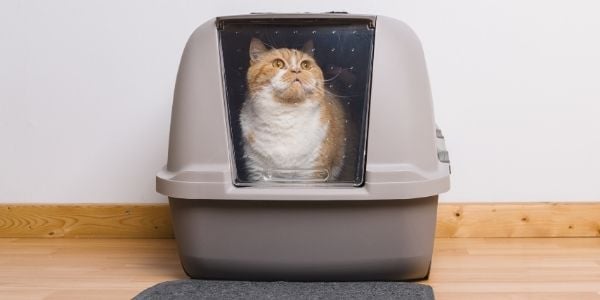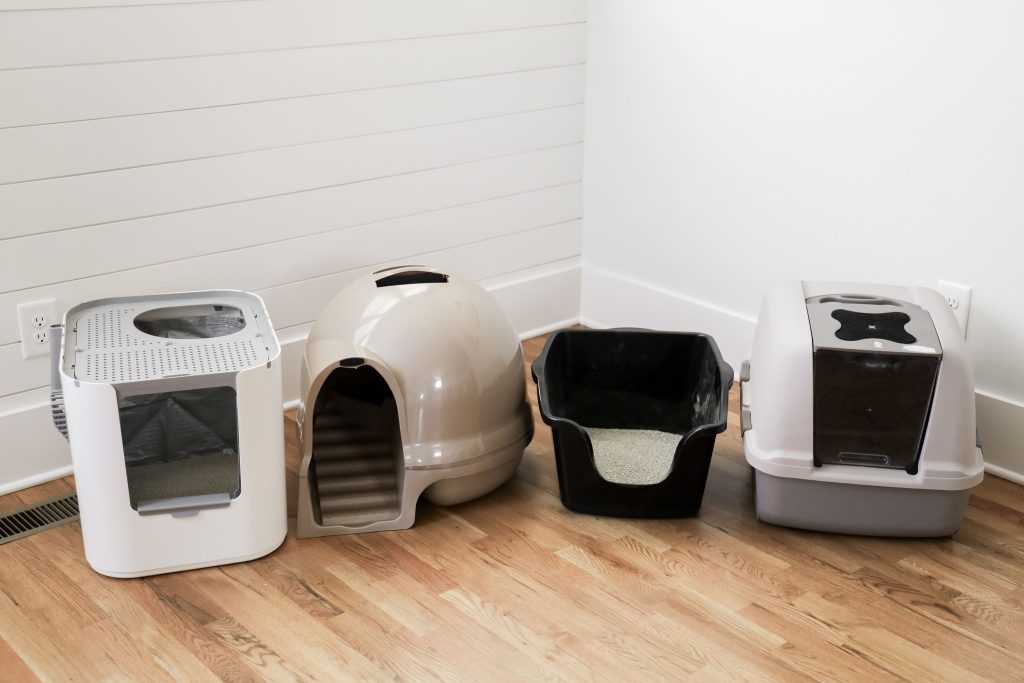There are four types of litter boxes: open, covered, self-cleaning, and top-entry. These litter boxes provide different options for cat owners based on their preferences and the needs of their cats.
Open litter boxes are simple and accessible, while covered litter boxes offer privacy and odor control. Self-cleaning litter boxes automate the cleaning process, and top-entry litter boxes minimize litter tracking. Each type of litter box has its advantages and disadvantages, allowing cat owners to choose the one that best suits their lifestyle and their cat’s behavior.
Proper litter box selection is crucial for a cat’s comfort and hygiene, as it can greatly influence their litter box habits and overall well-being.
Basic Litter Boxes
Traditional, open-top litter boxes are a popular choice for many cat owners. These litter boxes are simple in design and provide easy access for cats of all sizes. They come in various sizes and are typically rectangular in shape.
Covered litter boxes with a removable lid offer additional privacy for cats while containing the litter inside. The removable lid allows for easy cleaning and maintenance.
For specific needs, there are specialty litter boxes available. These include litter boxes designed for kittens or elderly cats, which may have lower sides to accommodate their small size or provide easier access for older cats with mobility issues.
Ultimately, the type of litter box you choose will depend on your cat’s preferences and your own preferences. Consider factors such as size, privacy, and ease of cleaning when selecting a litter box.
Advanced Litter Box Options
Advanced litter boxes offer a range of options to cater to the needs of both cats and their owners. Self-cleaning litter boxes are an innovative solution that eliminates the hassle of daily scooping. These automated litter boxes utilize sensors and timers to detect when a cat has used the box and automatically clean and replace the litter.
Another option is the use of litter boxes with built-in odor control systems. These boxes help keep the unpleasant odors at bay by incorporating filters or air purifiers that neutralize odors and ensure a fresh-smelling environment.
For households with multiple cats, multi-cat litter boxes with multiple compartments are a great choice. These boxes provide separate compartments for each cat, offering privacy and space for each feline friend.
Alternative Litter Box Solutions
When it comes to litter boxes, there are several alternative solutions available to meet the needs of cats and their owners. One option is top-entry litter boxes, which can help reduce tracking and odors. These boxes have a lid on top, allowing cats to enter from above, minimizing the amount of litter they can scatter outside the box. Another space-saving option is corner litter boxes, which are designed to fit neatly into the corner of a room. These boxes utilize the available space efficiently while still providing a comfortable area for cats to use. For those looking to maintain a clean and stylish living space, hidden litter box furniture is an excellent choice. These furniture pieces are designed to camouflage litter boxes, keeping them out of sight while still offering a functional and attractive solution. And for travel or convenience, disposable litter boxes are a hassle-free option. These boxes are made of lightweight and easily disposable materials, making them ideal for use when on the go or for temporary litter box needs.
Factors To Consider When Choosing A Litter Box
The size and dimensions of a litter box are crucial factors to consider when choosing the perfect one for your cat. **Cat comfort** should be a priority, ensuring that the litter box provides enough space for your cat to move around comfortably. It should also have **easy access and entry** to accommodate cats of all ages and sizes.
To keep your home free from unpleasant odors, opt for a litter box with effective **odor control features**. Look for options that trap odors and prevent them from spreading throughout your home.
Cleaning and maintenance requirements should also be taken into account. Choose a litter box that is easy to clean, with features like removable liners or trays for convenient disposal of litter.
**Durability** and quality of materials are important to ensure that the litter box withstands daily cat usage. Look for options made from sturdy materials that are built to last.
Lastly, consider your **budget**. There are a variety of litter box options available in different price ranges, so you can find one that suits your budget while meeting your cat’s needs.
Tips For Proper Litter Box Placement
Proper placement of litter boxes is important to ensure that your cats feel comfortable and have easy access to their designated areas. When providing litter boxes for multiple cats, it is advisable to have multiple boxes available. This helps prevent any potential conflicts or competition among the cats for litter box access.
Choosing the right location for your litter boxes is also crucial. Opt for quiet and private areas where your cats can eliminate without feeling anxious or disturbed. Avoid placing the litter boxes in high-traffic or noisy areas of your home, as this can also cause stress for your cats.
Easy access and escape routes are essential for your cats to feel safe and secure while using the litter boxes. Ensure that the boxes are easily reachable without any obstacles in their path. Additionally, having escape routes, such as multiple entrances or exits, allows your cats to quickly move away from the litter box area if they feel threatened or uncomfortable.

Credit: www.preventivevet.com
How To Best Maintain A Litter Box
|
Types of Litter Boxes How to Best Maintain a Litter Box Cleaning schedule and frequency Keeping your cat’s litter box clean and fresh is essential for their health and well-being. Establishing a regular cleaning schedule is the key to maintaining a clean litter box. Scooping the litter box at least once a day will prevent the build-up of waste and odor. It’s important to thoroughly **clean** the litter box at least once a week, removing all the old litter and washing it with mild **soap and water**. **Choosing the right litter** for your cat is also crucial. Consider their preferences and any **sensitivity** they may have to certain litters. It’s recommended to **refresh** the litter every few days to keep it smelling fresh, and completely **replace** the litter every two to four weeks. Additionally, if you use **liners**, make sure to **launder** or **replace** them as needed to maintain cleanliness. |
Common Litter Box Problems And Solutions
Common Litter Box Problems and Solutions:
Cat refusing to use the litter box: It can be frustrating when a cat refuses to use the litter box. This might be due to various reasons like a dirty litter box, an unappealing litter substrate, or a medical issue. It’s important to keep the litter box clean and provide a suitable litter that your cat finds comfortable.
Litter box aversion or anxiety: Some cats might develop aversion or anxiety towards their litter boxes. This can be caused by previous negative experiences or changes in the environment. Creating a positive association with the litter box by using positive reinforcement and providing a calm environment can help alleviate the issue.
Inappropriate elimination outside the litter box: If your cat is eliminating outside the litter box, it’s crucial to address this problem. It can indicate underlying health issues or territorial disputes. Consulting with a veterinarian and addressing any potential stressors can assist in resolving this problem.
Litter box aggression in multi-cat households: In multi-cat households, litter box aggression can occur due to competition for resources. Providing multiple litter boxes and ensuring they are placed in separate locations can help alleviate this issue.
Conclusion
To sum up, choosing the right litter box for your feline companion is essential for their comfort and your convenience. Whether you opt for a traditional open box, a covered box, or an automatic self-cleaning option, it’s crucial to consider your cat’s preferences and your own lifestyle.
Remember to provide ample space, cleanliness, and multiple litter boxes for multi-cat households. By understanding the different types of litter boxes available, you can ensure a happy and stress-free experience for both you and your beloved cat.


